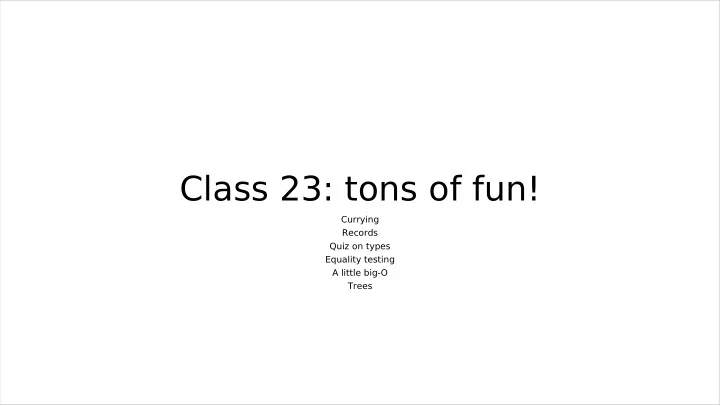

Class 23: tons of fun! Currying Records Quiz on types Equality testing A little big-O Trees
Announcement • Tuesday office hours, normally 1-2 PM, will be 1 – 1:40 tomorrow.
Currying • A transformation on functions • Named for Haskell Curry, a logician • Suppose we have two functions: let f1 : (int, int) => int = (x, y) => x + y + 1; let f2: int => (int => int) = x => (y => x + y + 1); • What's f1(2,4) ? • What's f2(2) ? • What's f2(2)(4) ? • What's f1(2) ? • Surprise! It's exactly the same as f2(2)!
• This correspondence is called "Currying". • Some languages go nuts with this; we mostly won't. • Automatic currying in Ocaml used to cause lots of problems for CS17 students • When we have a two (or more) argument function, we can "curry" on the first argument. • To curry on the second argument of f(x, y, z, w)… let g = (y, x, z, w) => f(x, y, z, w); g(2) …
A new bit of ReasonML syntax: records • Lists: expandable ordered collections of data (all the same type) • Tuples: aggregates of multiple pieces of data (possibly different types) • Records: like tuples, but with names for the pieces. • Remember the name-and-nickname database? ReasonML version 1: type entry = (string, string); type database = list(entry)
A new bit of ReasonML syntax: records • Remember the name-and-nickname database? ReasonML version 2: type entry = { name: string, nickname: string }; type database = list(entry) let pp = {name : "Porcellus Smith", nickname: "Porky Pig"};
Record use • When a datatype has multiple components, naming them can lead to clarity type ifExprData = { test: expression, trueResult: expression, falseResult: expression};
Example pattern-matching with records type s = {a:int, b:bool}; let f: s => bool = fun | {a:_, b:true} => false | {a:_, b:false} => true;
Quiz on types • Write down the types for each of the following: a) (1, 2.5) b) let f = fun | "abc" => true | _ => false; c) let g = fun | [] => true | [[_]] => false | _ => true;
Equality testing • We can test whether numbers or bools or strings or lists of these things are equal • What about equality of functions? • Provably hard! (take CS1010) • Racket solve this by saying that "equal?" behavior on function types is undefined. (I think it always returns "false" in practice.) • For Rackette: you only need to handle non-function types.
A last visit to some big-O stuff
Bootstrapping lemma
Applying bootstrapping
Almost done with ReasonML syntax • Remaining item: modules, later this week. • What else is left? • All of computer science! • Particular things we'll look at • Stacks and Queues • Sorting • Trees • Binary Search Trees • Game Trees • Minimax algorithm
Binary trees • A binary tree is something that looks like this: 4 2 6 5
Binary tree terms • "Leaf": one of the filled-in dots at the bottom • "Node": one of the circular things with a number in it • The thing in a node could be a number, a string, a list… • but all nodes in a tree will contain the same type of value • Type definition in ReasonML: type tree('a) = Leaf | Node('a, tree('a), tree('a))
Binary trees let s:tree(int) = Node(4, Node(6, Leaf, Node(5, Leaf, Leaf), 4 Node(2, Leaf, Leaf)); 2 6 5
Terminology 4 • Depth of a tree: longest sequence of edges. • Example has depth 3 2 • Also called height 6 • Root node: the one at the top • Depth of a node: number of edges to get to the root. Root is at depth 0. 5 • Typical tree-drawing: omit leaves!
Tree depths
Tree depths (cont)
What makes trees interesting • Lists attach a single item to something (possibly) more complicated: (cons 1 (list 3 4)) • Trees attach a single item to two things, each possibly more complicated. • Shift from 1 to 2 introduces complexity and (in some cases) efficiency!
treeContains17 • Recall typedefinition: type tree('a) = Leaf | Node('a, tree('a), tree('a)) • Write a procedure: let treeContains17 : tree(int) => bool = fun | Leaf => ... | Node(val, left, right) => ...
Recommend
More recommend